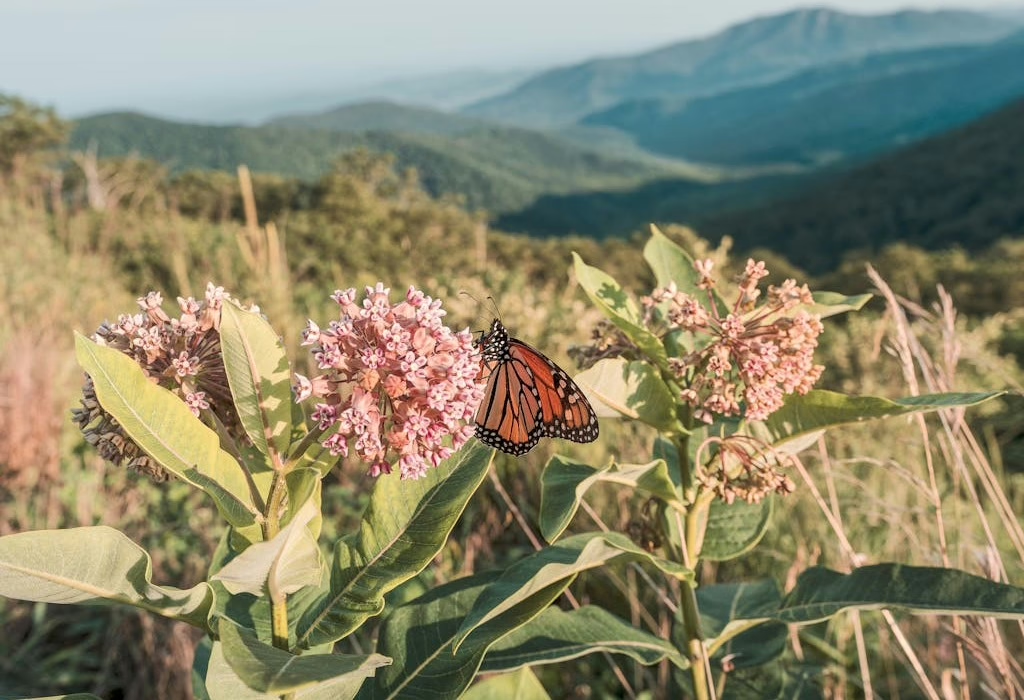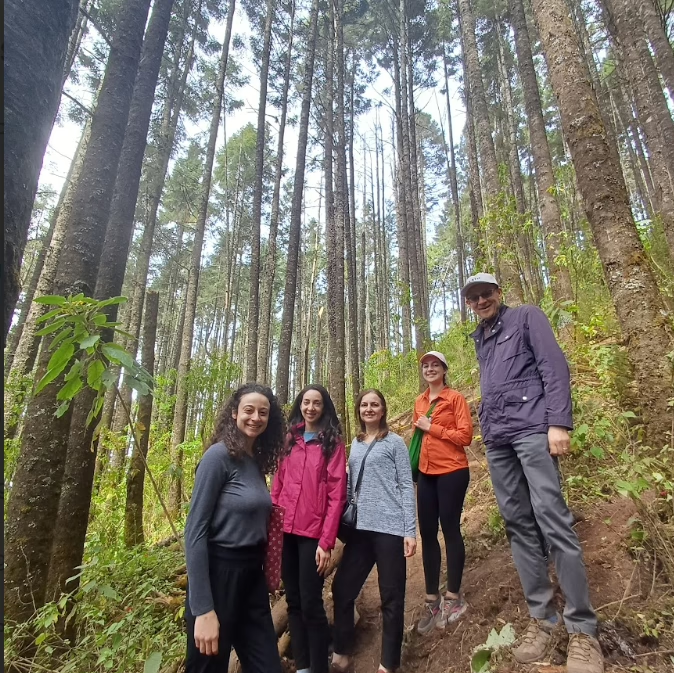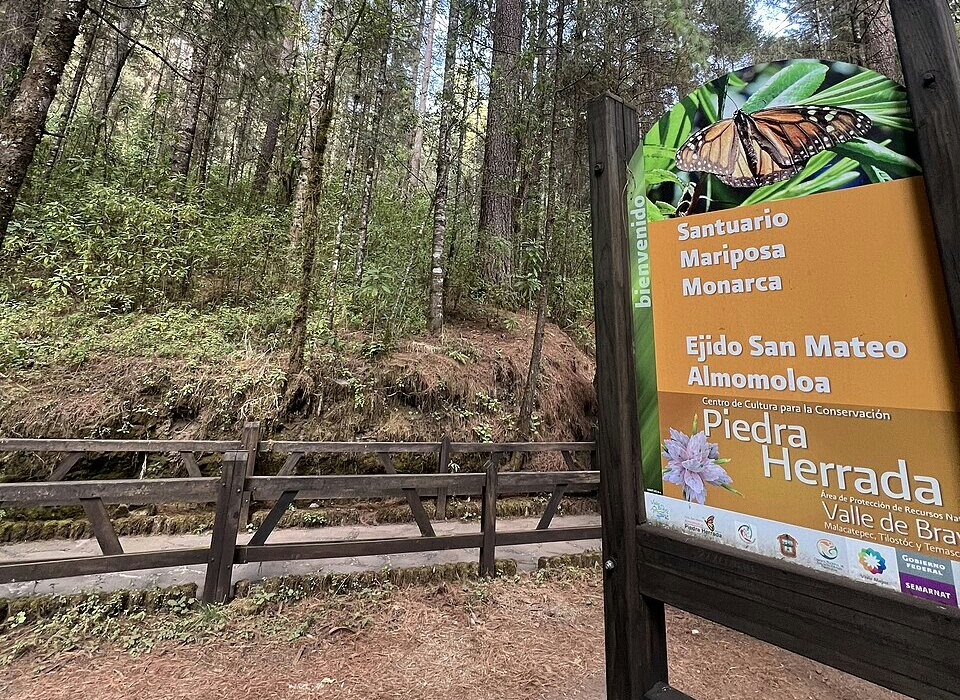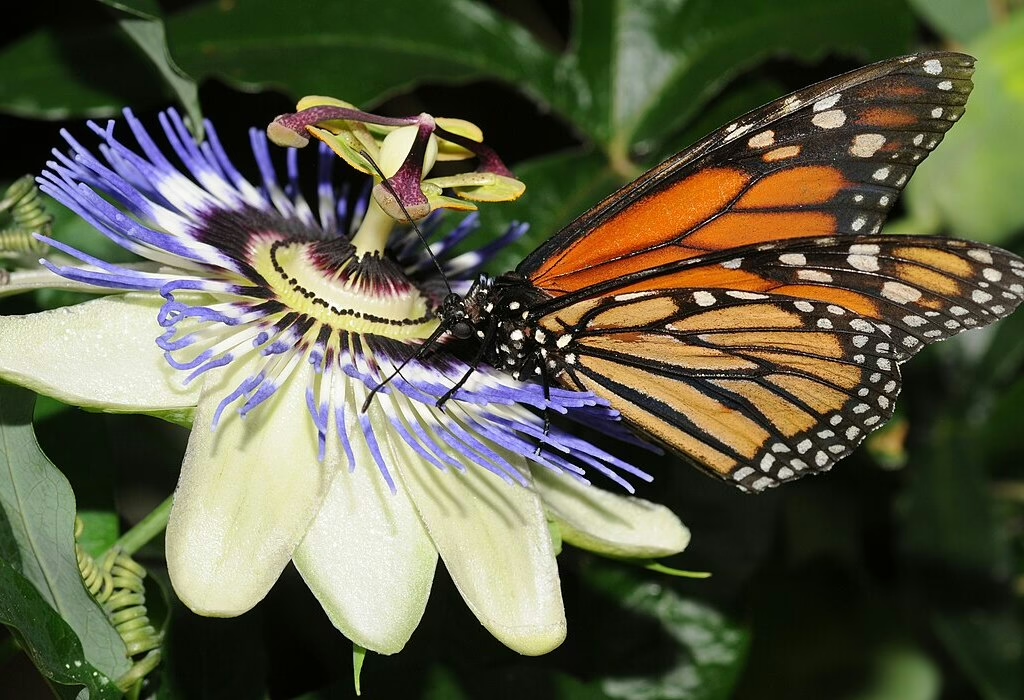Table of contents:
- Introduction 🦋
- When is the monarch butterfly season? 🦋
- Visitor Guide: Essential Rules for the Sanctuary 🦋
- Comparing the 5 Official Sanctuaries Open to the Public🦋
- Sierra Chincua 🦋
- Santuario Ejido El Capulín 🦋
- El Rosario 🦋
- Santuario Piedra Herrada 🦋
- Santuario La Mesa 🦋
- More about Monarch Butterflies 🦋
- Frequently Asked Questions 🦋
- Conclusion 🦋
- Informative Video 🦋
Introduction
Get ready to admire Monarch butterflies in Mexico and learn everything about where to see them! Indeed, the Monarch Butterfly Sanctuary in Mexico is a beautiful sight that attracts many visitors each year. The butterflies travel from Canada to Mexico between November and March. They find safe places to rest in several sanctuaries before heading back to the United States in spring. The Monarch Butterfly Biosphere Reserve, a UNESCO World Heritage Site since 2008, covers more than 16,100 hectares across two Mexican states and is home to these butterflies.
If you’d like to observe this spectacle, there are numerous sanctuaries to go to. There is something very special about each one, beautiful forests and great vantage points to see the butterflies rest on the trees. Whether you are walking about Sierra Chincua, traversing Santuario Piedra Herrada or reveling in the tranquility of El Rosario, there’s a sanctuary for you. In some places, you can even hire a guide, rent a horse and sleep in comfortable cabins.

Visiting the Monarch Butterfly sanctuaries is not just about seeing the butterflies but also learning about their long journey and the important role they play in nature. The monarchs are at risk due to climate change, and the sanctuaries help protect them. Besides the butterflies, visitors can enjoy nature, relax outdoors, and admire Mexico’s beautiful landscapes.
This article gives helpful details about the top Monarch Butterfly sanctuaries, including their opening hours, entry fees, and directions. It also gives advice on what to bring, like comfortable clothes, a backpack, and money. Whether you are a regular traveler or visiting for the first time, seeing the Monarch butterfly migration in Mexico will be an unforgettable experience.
When is the monarch butterfly season?
Every winter, between November and March, millions of monarch butterflies dress the forests of central-western Mexico in orange, whitish, and black tones. After traveling thousands of kilometers from Canadian lands, this little flier arrives at the Mexican states’ forests.
For over 40 years, these beautiful creatures have been coming here to reproduce and find their new home. The most famous sanctuary, Piedra Herrada, was constructed to protect this unique biological phenomenon. This place is part of the Monarch Butterfly Biosphere Reserve, which was declared a Natural World Heritage Site by UNESCO in 2008. Currently, the reserve covers an area of over 16,100 hectares shared by 10 municipalities in two Mexican states.

When is the best time to visit?
The Monarch butterflies do not like the cold. To see them fly high in those big orange clouds—the amazing sight you came for—you must be there when the sun is warmest.
Not a Good Time:
- Early morning (8:00 AM to 10:00 AM)
- Late afternoon (3:00 PM to 5:00 PM)
Why? It is too cold then. The butterflies just stay still, grouped together on the Oyamel trees. They wait for the sun.
The Best Time to Visit:
- The perfect time is 11:30 AM to 2:30 PM.
The sun has warmed up the air by then. This makes the butterflies wake up and fly! They come down to get water, flutter around, and begin their mating.
Simple Tip: When the sun hits the trees, the butterflies take off. It is the best moment of the whole trip. Try to plan your walking so you arrive at the spot right before 12:00 PM (noon).
🦋 Admire monarch butterflies closely with our tours:
- Monarch Butterfly Tour Mexico (Private Guide & Driver / Private / 12h)
- Mexico Monarch Butterfly (Sanctuary & Christmas / Private / 14h)
- Monarch Butterfly Sanctuary in Piedra Herrada and Valle Tour (12h)

Visitor Guide: Essential Rules for the Sanctuary
Protecting the Monarchs and Their Home
When you come to the Monarch Butterfly area, remember it is a very important, protected place. This is the final resting spot for millions of butterflies after their long trip! The most important rule is Do Not Touch the Butterflies. Monarchs are super delicate. If you touch them, you can break the tiny scales on their wings, and they won’t be able to fly back home. To keep them safe, please stay on the marked paths and be totally quiet when you see them. Loud noises can scare them, making them fly and waste the energy they need for their long trip back.

Being Kind to the Place and Other People
We want to keep the sanctuary beautiful for everyone, so please follow these simple steps: Do not use your camera flash near the butterflies—it wakes them up when they need to rest. Leave your food, drinks, and pets near the entrance. The people who work here as guides know everything! Always get a local guide and listen to what they say. They will take you to the best places safely. Coming here is a special chance, and by following these few rules, you help save this incredible butterfly trip for everyone who comes next.
Comparing the 5 Official Sanctuaries Open to the Public
When you plan your trip, you get to pick from five main spots. It helps to think about two things: where you start your day and how much you like to walk. If you are driving from a big city like Mexico City (CDMX) or the town of Valle de Bravo, you should look at the places in the State of Mexico. The best choice there is often Piedra Herrada because the drive is shorter. But be careful: a place like Ejido El Capulín means you must do a long, hard walk uphill. If you start closer to towns like Angangueo or Morelia, then the spots in Michoacán—El Rosario and Sierra Chincua—will be easier to reach.

El Rosario is the most popular and the largest spot, but it gets very full of people on Saturdays and Sundays, and the walk up is quite long. Sierra Chincua is a wonderful choice; it usually has fewer people, and the path is not as hard to walk, so it feels more calm and peaceful. You can think of El Rosario like a huge party, while Sierra Chincua is a quiet, beautiful nature walk. No matter which one you choose, all five will give you the same beautiful sight: millions of Monarch butterflies! Just ask about the path difficulty before you buy your ticket.
Below are the top 5 sanctuaries that you can visit.
The times and dates for the butterfly places might change, sometimes because of Mexican holidays. You should always check the schedules ahead of time with your tour operator or by yourself. Also, we think it is smart to always bring the following things to make your visit easy and comfortable:
- Comfortable travel backpack
- Comfortable clothing
- Jacket
- Money
1. Sierra Chincua: The Most Accessible Option 📍
It is located very close to Angangueo. Here, you will find experienced guides who will provide you with information about the animals and plants of the place.
Monarch butterflies stand out for living around 9 months, much more than others. To arrive at this sanctuary, you need to hike around 2.5 km. But don’t worry; you will be fully rewarded as you will see numerous breathtaking views along the way. The facilities include a restaurant, a parking lot, and a particular camping area.
How to get there?
Departing from Mexico City is approximately a 3-hour drive. You should travel by bus (departure times to this destination are at the Obsertvatorio bus terminal) to Zitacuaro. Once you arrive in Zitacuaro, ask a taxi to take you to Angangueo, this mini-magical town with butterflies on the poles that will guide you to the Sierra Chincua Sanctuary.
Sierra Chincua Opening Hours:
| Monday | 8:00–17:00 |
| Tuesday | 8:00–17:00 |
| Wednesday | 8:00–17:00 |
| Thursday | 8:00–17:00 |
| Friday | 8:00–17:00 |
| Saturday | 8:00–17:00 |
| Sunday | 8:00–17:00 |
Sierra Chincua Entrance Cost:
General admission is $100 pesos for adults ($70 pesos for children). Hiring a horse for a round trip usually costs between $300 and $340 pesos (this rate is paid directly to the local riders).
“Heads up! (Important Note): Prices are subject to change without notice by CONANP and local communities. Always carry Mexican Pesos (MXN) in cash, as cards are not accepted.”
2. Santuario Ejido El Capulín: The Challenging Mountain Hike 📍
You can reach this sanctuary on Cerro Pelón Mountain on the 4-km hike. The area is a total of beautiful landscapes with impressive forests that attract millions of monarch butterflies to hibernate here yearly. Here, you will find horse rentals, tables for family meals, and typical snack stores. Affordable cabins are available, and it is perfect for being close to nature. El Capulín is located in Donato Guerra, 80 km west of Toluca.
How to get there?
Departing from Mexico City, this place is approximately 2 hours and 30 minutes away. As in Sierra Chincua, the best way to get to Zitacuaro is to leave the Poniente bus terminal (Observatorio). For a visit to the sanctuary, it is best to rent a taxi from Zitacuaro, and in 30 minutes, you will be at the sanctuary enjoying the monarch butterflies.
Ejido el Capulín Opening Hours:
| Monday | 9:00–17:00 |
| Tuesday | 9:00–17:00 |
| Wednesday | 9:00–17:00 |
| Thursday | 9:00–17:00 |
| Friday | 9:00–17:00 |
| Saturday | 9:00–17:00 |
| Sunday | 9:00–17:00 |
Ejido el Capulín Entrance Cost:
General admission is approximately $100 pesos per person. The cost to hire a horse for the ascent and descent is generally around $300 pesos. Remember, these rates may change depending on the season, and it’s best to pay in cash.
3. El Rosario: The Largest and Most Visited Sanctuary 📍
El Rosario is one of the most beautiful sanctuaries of the Monarch butterfly. This reserve will take you through the interior of a dense mixed forest of pine and fir. The hills are home to millions of Monarch butterflies in their thick trunks and leafy branches, making these trees their home each year. To reach this site, you must ascend the mountain for approximately 2 kilometers. You can do it either on foot or on horseback.
We also recommend hiring a local guide. In addition to getting to the exact place where butterflies live, you will learn about their characteristics and other curious information. This is the largest reserve in Mexico, so you will not regret it.
How to get there?
The distance between Mexico City and El Rosario Sanctuary is 3 hours. To get to Sierra Chincua, you have to follow the steps we mentioned. The only difference is that when you get to Angangueo, ask a cab to take you to this shrine, which is a little further ahead of Sierra Chincua.
El Rosario Opening Hours:
| Monday | 8:00–17:00 |
| Tuesday | 8:00–17:00 |
| Wednesday | 8:00–17:00 |
| Thursday | 8:00–17:00 |
| Friday | 8:00–17:00 |
| Saturday | 8:00–17:00 |
| Sunday | 8:00–17:00 |
El Rosario Entrance Cost:
The entrance fee to this sanctuary is $100 pesos for Adults and $70 pesos for children (under 12 years old). If you wish to hire a horse for the round trip, the price is approximately $340 pesos.
4. Santuario Piedra Herrada: Closest Sanctuary to Mexico City (CDMX) 📍
To get to the sanctuary, one has to walk for 40 minutes up the slope of the Nevado de Toluca volcano. The landscape there consists of imposing mountains of more than 3,000 meters in altitude. Butterflies are attracted by omels, a local species of pine trees. These trees are essential in providing them with the necessary conditions to grow and reproduce.
How to get there?
It is the closest sanctuary to Mexico City since it is only 1 hour and 59 minutes away and can be reached from Mexico City or Valle de Bravo. If you travel by car, take the Toluca highway to Temascaltepec, then turn off towards Valle de Bravo, and you will find the road to Piedra Herrada.
Piedra Herrada Opening Hours:
| Monday | 9:00–16:00 |
| Tuesday | 9:00–16:00 |
| Wednesday | 9:00–16:00 |
| Thursday | 9:00–16:00 |
| Friday | 9:00–16:00 |
| Saturday | 9:00–16:00 |
| Sunday | 9:00–16:00 |
Piedra Herrada Entrance Cost:
Admission to the sanctuary is $150 pesos for adults and $100 pesos for children (3-11 years old). The cost to rent a horse for the round trip is consistently around $300 pesos.

5. Santuario La Mesa: Ideal for Families (Deer Farm) 📍
Located at the foot of the mountains that separate Michoacan and the Estado de Mexico (State of Mexico), this sanctuary is home to thousands of monarch butterflies in winter. There is a tourist hostel with cabins, restaurants, viewpoints, and trails ideal for biking. Furthermore, you can rent horses and hire local guides where butterflies stay.
How to get there?
This sanctuary is also one of the closest to Mexico City. If you travel by bus from Mexico City, it is best to leave from the Poniente Bus Terminal (Observatorio). Take the bus to Villa Victoria and San Jose del Rincon. At Guadalupe stop (parada de Guadalupe) board a local taxi that will take you to the sanctuary.
La Mesa Opening Hours:
| Monday | 9:00–17:00 |
| Tuesday | 9:00–17:00 |
| Wednesday | 9:00–17:00 |
| Thursday | 9:00–17:00 |
| Friday | 9:00–17:00 |
| Saturday | 9:00–17:00 |
| Sunday | 9:00–17:00 |
La Mesa Entrance Cost:
This sanctuary generally charges an entrance fee of $100 pesos per person. It is ideal for nature lovers and offers the unique feature of a deer hatchery, which is perfect for kids.
More about Monarch Butterflies
The most amazing thing about the Monarchs is their long trip! It is not just one butterfly that flies all the way. The butterflies you see in Canada or the US only live for a few weeks. It takes four different families of butterflies to fly north over the whole summer. But the last group, the one that comes to Mexico in the fall, is very special. They are the “super butterflies.” They are the only ones that live for seven to nine months! They fly thousands of miles south, sleep all winter in the Mexican mountains, and then start flying north in the spring. We still do not know how they find the same small forest every time. It’s a great mystery in nature!

The Monarchs fly to Mexico because they need a perfect home for the cold months. They need a place that is only a little bit cold so they can stay asleep and save energy, but not so cold that they die. The Oyamel trees in the Michoacan mountains are perfect. These tall, thick trees work like a giant blanket. When millions of butterflies group together, they keep the center of the colony warm, safe from rain, and just the right temperature. If they did not have this exact kind of forest, the whole trip could not happen.
Alongside this information, some people are not sure if Michoacan or its surroundings are an excellent option to travel to due to the insecurity of Mexico. Nevertheless, in this country, there are many contrasts and not only negativity. For example, I will cite the article by Partyingtraveler:
“Seeing millions of monarchs fluttering about is something that I hope everyone can experience in their lifetime. Of all the things I’ve seen in my travels, witnessing the monarch butterfly migration in Mexico has nothing else I could compare it to”.
Frequently Asked Questions
1. Are there butterfly sanctuary volunteer programs in Mexico?
A: Yes, sometimes. These butterfly places are part of a big protected nature zone. If you want to help, you can look for volunteer jobs run by local groups or big nature companies. It is best to search online for “Monarch volunteer” before your trip to see who needs help that season.
2. What travel agencies specialize in butterfly sanctuary trips in Mexico?
A: Many different companies do these trips. You can find tours from large companies, but also great trips from small, local Mexican travel offices in towns like Angangueo. Try to choose groups that use local certified guides. They know the area best and help the local people.
3. Can I buy butterfly sanctuary tour packages that include transportation from the US?
A: Yes, you can. These are usually sold as trips that last many days. They pay for your flights, hotels, and all the bus rides to the butterfly spots. These packages often start in a big city like Mexico City. They are the easiest way to travel if you are flying from far away.
4. Are there butterfly sanctuary tours that combine cultural experiences in Mexico?
A: Yes, for sure! Many of the best trips take you to the mountains and also visit the special “Magic Towns” (Pueblos Mágicos) nearby, like Angangueo or Valle de Bravo. This way, you get to see the amazing butterflies and enjoy the local Mexican history, food, and pretty buildings.
5. Are there butterfly sanctuary photography tours in Mexico?
A: Yes, you can find special trips just for people who love taking pictures. The best time to see the butterflies fly is only for a few hours (around noon). These tours plan to be at the perfect spot at the perfect time for good light. They will also teach you how to take great photos without using your flash.
6. Which Mexican butterfly sanctuaries have visitor centers with guided educational programs?
A: The two main places, El Rosario and Sierra Chincua, have simple visitor areas near the entrance. They give out information and find you a local guide to take you up the mountain. Sometimes you can watch a short movie or see a small display about the Monarch’s life.
7. How to find affordable butterfly sanctuary tours in Mexico with group discounts?
A: The best way to spend less money is to go on a big group day trip from Mexico City. This way, you share the cost of the bus. If you go with a group of friends, you can ask for a lower price when you rent a private van and local guide together. Always check if the tour ticket includes the entrance fee.
8. Are there any mobile apps for self-guided butterfly sanctuary tours in Mexico?
A: No, not really. You must always walk with a local guide once you go past the main gate. You cannot go alone with just an app. The guides know exactly where the butterflies are resting that day and make sure you stay safe on the mountain paths.
9. What companies offer butterfly sanctuary and nature reserve combined tours in Mexico?
A: Many tour groups offer this. The butterfly places are inside a huge protected area. It is easy to find tours that let you see the butterflies and visit other nature spots, like nearby lakes, waterfalls (like Velo de Novia), or other mountain areas for hiking.
10. What gear or products should I bring for visiting a butterfly sanctuary in Mexico?
A: Remember the mountain air is very high and the sun is strong! Always bring sunscreen and a hat to protect your face. Also, carry water and some small snacks for energy during the long walk up and down the mountain.
Conclusion
In conclusion, a visit to a butterfly sanctuary in Mexico is a chance to experience one of the most amazing natural events in the world. The monarch butterflies, after traveling long distances, find a safe home in the forests of Mexico. These sanctuaries offer visitors the chance to see the butterflies closely and learn about their life cycle and migration.
The butterfly sanctuary in Mexico is not just about observing the butterflies; it’s also an opportunity to connect with nature. Visitors can enjoy peaceful walks in the forest, see beautiful landscapes, and take in the fresh air. For those who want a more adventurous experience, some sanctuaries offer guided tours, horseback riding, and places to stay near the sanctuary.

Moreover, visiting these sanctuaries gives people a better understanding of the importance of protecting the environment. The monarch butterflies are vulnerable to changes in the climate, and sanctuaries play an important role in helping to protect them. By supporting these sanctuaries, visitors help preserve this beautiful migration for future generations.
Butterfly sanctuaries in Mexico are spread across the country which means that lots of people have easy access to them. First time or not, you’ll have an unforgettable time on this trip to Mexico. It’s a peaceful setting, and a chance to see something beautiful in nature while learning more about the monarch butterflies.
Put simply, a butterfly sanctuary in Mexico is a rare experience that we as nature lovers, families and travelers who care for the planet need to experience. It’s an opportunity to learn, discover and enjoy the beauty of one of the world’s most remarkable natural migrations. A trip to a butterfly sanctuary in Mexico is a dream come true come experience.
